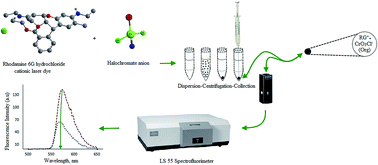An ultrasound-assisted ion association dispersive liquid–liquid microextraction coupled with micro-volume spectrofluorimetry for chromium speciation
Abstract
A micro-volume spectrofluorimetric coupled ultrasound-assisted ion association dispersive liquid–liquid microextraction (USA-IA-DLLME) procedure for the total determination and speciation of chromium(III & VI) species has been established. This demonstration was based upon the formation of a complex ion associate between halochromate (CrO3Cl−) and rhodamine 6G hydrochloride dye (RG+). At optimal conditions, the method exhibited a three order of magnitude wide linear concentration range (1.0–1000 μg L−1), with detection and quantification limits of 0.57 μg L−1 and 1.9 μg L−1, respectively. Competent cations, anions and oxoanions did not interfere with the chromium(VI) determination. Chromium(III) was also evaluated after its conversion to chromate with H2O2 in alkaline media. The nature of the extractant and the disperser, their volumes and the extraction time were optimized. The fluorescence quenching mechanism of the complex ion associate was discussed. The method was validated by the determination of chromium(VI) in real water (sea and tap water) samples. The results were also compared successfully with those from inductively coupled plasma-optical emission spectrometry (ICP-OES) in terms of the student’s t- and F test data at 95% confidence.


 Please wait while we load your content...
Please wait while we load your content...